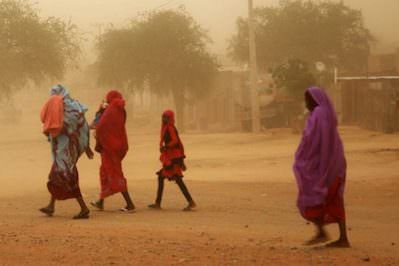Africa’s Dust Is a Priceless Export
Scientists show how different the world would be without a sprinkling of wind-borne fine particles from Africa that fertilize oceans and forests.
By Tim Radford / Climate News Network

Women and children struggle through a dust storm in North Darfur, Sudan. (UNAMID via Flickr)
LONDON — Climate scientists have identified Africa’s single biggest export — the wind-borne dust that fertilises the Amazon forests, nourishes life in the Atlantic ocean and softens the noonday blaze of the sun. And they have calculated its vital role in climate change over the last 23,000 years.
In the words of US oceanographers and Earth scientists, “North Africa exports teragrams of wind-blown mineral aerosol over the tropical North Atlantic each year, with significant climate and biogeochemical impacts.”
A teragram is a million tonnes, and the quantities airlifted into the sky from the Sahara and the Sahel each year by the trade winds and blown abroad would be enough to fill 10 million heavy trucks.
About 11,000 years ago, the continent’s total exports of fine dust began to fall dramatically, the researchers report in Science Advances journal.
Fine particles
The lower levels of fine particles in the sky may have allowed more sunlight to hit the ocean waters, may have warmed surface temperatures by 0.15°C, and may have helped whip up monsoons over North Africa to make the conditions far more temperate than they are today.
“In the tropical ocean, fractions of a degree can cause big differences in precipitation patterns and winds,” says one of the report’s authors, David McGee, assistant professor of paleoclimate and geochronology at the Massachusetts Institute of Technology.
“It does seem like dust variations may have large enough effects that it’s important to know how big those impacts are on past and future climates.”
Researchers have already established the importance of windblown dust, both as a source of mineral nutrient for marine life and for the rainforests of Brazil. Scientists have even identified dust kicked into the air by heavy rain.
We need to figure out how big those dust impacts are, to understand both past and future climates
But the latest study focused on the changing pattern of dust delivery from the peak of the last Ice Age to the present, the role it may have played in bygone climate change, and its importance in the human story.
North Africa was once a more temperate and hospitable place. Dr McGee says: “There was also extensive human settlement throughout the Sahara, with lifestyles that would never be possible today.
“Researchers at archaeological sites have found fish hooks and spears in the middle of the Sahara, in places that would be completely uninhabitable today. So there was clearly much more water and precipitation over the Sahara.”
Some of this may be explained by subtle cyclic shifts in the planetary axis, exposing the northern hemisphere to more sunlight, more evaporation and more rainfall over land.
Dust sediments
But climate models suggest that this might not be enough, so the researchers examined dust sediments deposited in the Bahamas over the last 23,000 years to identify the role of dust.
Towards the end of the last Ice Age, 16,000 years ago, African dust exports were twice what they are today. But between 11,000 and 5,000 years ago, Africa exported only about half the dust it airlifts now.
The implication is that wind-blown dust is an important factor in climate science, and even small changes in sea surface temperatures — of the sort that could be attributed to dusty skies — can have big effects on Atlantic winds and African rainfall.
“We’re not saying, the expansion of monsoon rains into the Sahara was caused solely by dust impacts,” Dr McGee says. “We’re saying we need to figure out how big those dust impacts are, to understand both past and future climates.”
Tim Radford, a founding editor of Climate News Network, worked for The Guardian for 32 years, for most of that time as science editor. He has been covering climate change since 1988.
Your support is crucial…With an uncertain future and a new administration casting doubt on press freedoms, the danger is clear: The truth is at risk.
Now is the time to give. Your tax-deductible support allows us to dig deeper, delivering fearless investigative reporting and analysis that exposes what’s really happening — without compromise.
Stand with our courageous journalists. Donate today to protect a free press, uphold democracy and unearth untold stories.









You need to be a supporter to comment.
There are currently no responses to this article.
Be the first to respond.